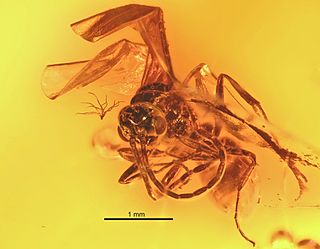
Liometopum is a genus of ants that belongs to the subfamily Dolichoderinae, found in North America, Europe and Asia.

Archimyrmex is an extinct genus of ant in the formicid subfamily Myrmeciinae, described by palaeoentomologist Theodore Cockerell in 1923. The genus contains four described species, Archimyrmex rostratus, Archimyrmex piatnitzkyi, Archimyrmex smekali and Archimyrmex wedmannae. Archimyrmex is known from a group of Middle Eocene fossils which were found in North America, South America, and Europe. The genus was initially placed in the subfamily Ponerinae, but it was later placed in Myrmeciinae; it is now believed to be the ancestor of the extant primitive genus Myrmecia from Australia. Despite this, Archimyrmex is not a member to any tribe and is regarded as incertae sedis within Myrmeciinae. However, some authors believe Archimyrmex should be assigned as incertae sedis within Formicidae. These ants can be characterised by their large mandibles and body length, ranging from 13.2 to 30 mm. They also have long, thin legs and an elongated mesosoma (thorax) and petiole.

Attopsis is an extinct genus of ants in the formicid subfamily Formicinae. While formerly containing a number of species, the genus is currently monotypic; the type species, Attopsis longipennis, is known from a single Early Miocene fossil found in what is now Croatia.

Emplastus is an extinct morphogenus of ants in the subfamily Dolichoderinae, known from fossils found in Asia and Europe. The genus contains twelve species described from sites in England, Eastern Europe and Far Eastern Russia.

Casaleia is an extinct genus of ants in the formicid subfamily Amblyoponinae described by Pagliano & Scaramozzino in 1990 from fossils found in Europe. The genus contains four species dating from the Eocene to Miocene, Casaleia eocenica, Casaleia inversa, Casaleia longiventris, Casaleia orientalis.

Yantaromyrmex is an extinct genus of ants first described in 2013. Members of this genus are in the subfamily Dolichoderinae of the family Formicidae, known from Middle Eocene to Early Oligocene fossils found in Europe. The genus currently contains five described species, Y. constrictus, Y. geinitzi, Y. intermedius, Y. mayrianum and Y. samlandicus. The first specimens were collected in 1868 and studied by Austrian entomologist Gustav Mayr, who originally placed the fossils in other ant genera until the fossils were reviewed and subsequently placed into their own genus. These ants are small, measuring from 4 to 6 mm in length and can be characterized by their trapezoidal shaped head-capsules and oval compound eyes that are located slightly to the rear of the capsules midpoint, with no known ocelli present.
Liometopum brunascens is an extinct species of Miocene ant in the genus Liometopum. Described by Heer in 1867, the fossils were found and described from Croatia.
Liometopum crassinervis is an extinct species of Miocene ants in the genus Liometopum. Described by Heer in 1849, fossils of the species were found in Switzerland.
Liometopum croaticum is an extinct species of Miocene ant in the genus Liometopum. Described by Heer in 1849, the fossils were found in Croatia.
Liometopum escheri is an extinct species of Miocene ant in the genus Liometopum. Described by Heer in 1867, fossils of the species were found in Switzerland.
Liometopum globosum is an extinct species of Miocene ant in the genus Liometopum. Described by Heer in 1849, the fossils were found in Switzerland.
Liometopum longaevum is an extinct species of Miocene ant in the genus Liometopum. Described by Heer in 1849, the fossils were found in Switzerland.
Liometopum pallidum is an extinct species of Miocene ant in the genus Liometopum. Described by Heer in 1867, the fossils were found in Croatia.
Liometopum stygium is an extinct species of Miocene ants in the genus Liometopum. Described by Heer in 1867, fossils of the species were found in Switzerland.
Liometopum venerarium is an extinct species of Miocene ants in the genus Liometopum. Described by Heer in 1864, fossils of the species were found in Switzerland.
Liometopum ventrosum is an extinct species of Miocene ants in the genus Liometopum. Described by Heer in 1849, fossils of the species were found in Switzerland.

Cyrtopone is an extinct genus of ants in the formicid subfamily Ponerinae described from fossils found in Europe. There are four described species placed into the genus, Cyrtopone curiosa, Cyrtopone elongata, Cyrtopone microcephala, and Cyrtopone striata. Cyrtopone is one several Lutetian Ponerinae genera.

Messelepone is an extinct genus of ants in the formicid subfamily Ponerinae described from fossils found in Europe. M. leptogenoides is the only species assigned to the genus, which is one of several Lutetian Ponerinae genera.

Pachycondyla succinea is an extinct species of ant in the formicid subfamily Ponerinae described from fossils found in Europe. P. petrosa is one of three middle Eocene Pachycondyla species found in Baltic amber.

Nylanderia pygmaea is an extinct species of formicid in the ant subfamily Formicinae known from fossils found in the Prussian Formation of the Baltic region.










